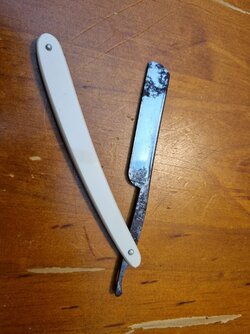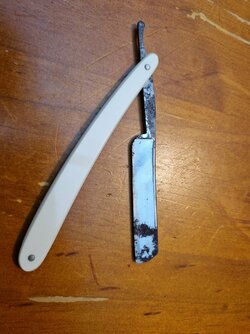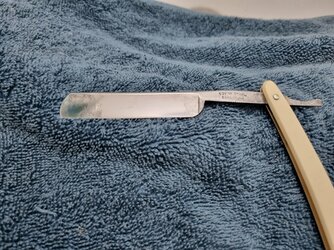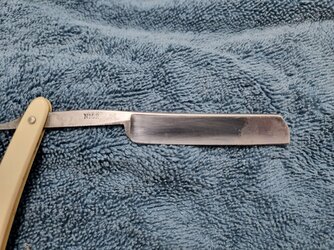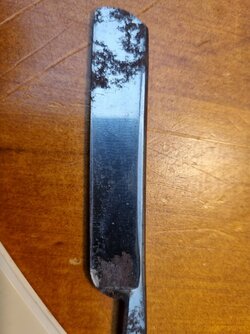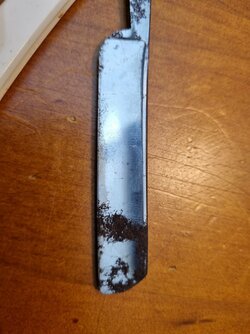So...decided to restore the razor I inherited from my father, only to find out that it is quite something special (pre-war Puma 6/8...) so I've decided that an expert will restore that one, as I really don't want to damage anything.
However, me being me, I've watched a lot of razor restoration videos and I'm itching to get my hands dirty...so I have bought several old razors in need of TLC, and none have cost more than 25 bucks and none have sentimental value so I won't cry if I ruin one.
First cab off the rank is an Eskilstuna 5/8 from Edv Neiström.
Basically in fairly decent condition apart from a couple of fairly nasty rust spots, but it cost me ten bucks so here goes...
The steel on this thing is hard as all fury!!!
A good hour with 120 grit silicon carbide wet and dry has cleaned the rust off, but hardly touched the pitting...
I know at some point I will be removing the scales and will have a go again, but for now I've left some pitting and given it a run through the grits to 800 and a touch up with Autosol.
It looks OK, but not perfect.
Will do for now.
I think the edge is slightly bent maybe... one side doesn't want to hone near the toe but hones in the middle nicely.
Flip it over and that side hones the toe just fine.
I only have a 1000 grit Japanese synthetic and an old small natural hone possibly Arkansas of unknown grit.
I haven't got a proper strop yet, I'm using an old leather belt.
So far I've got it popping arm hairs like a champion, but failing the HHT and it pulls when I try to shave with it.
I got a shave though.
I'll be using this one to learn honing until I can make it sing, then it will be a user and eventually I will dismantle it and clean up the tang properly and get those rust pits out whatever it takes.
However, me being me, I've watched a lot of razor restoration videos and I'm itching to get my hands dirty...so I have bought several old razors in need of TLC, and none have cost more than 25 bucks and none have sentimental value so I won't cry if I ruin one.
First cab off the rank is an Eskilstuna 5/8 from Edv Neiström.
Basically in fairly decent condition apart from a couple of fairly nasty rust spots, but it cost me ten bucks so here goes...
The steel on this thing is hard as all fury!!!
A good hour with 120 grit silicon carbide wet and dry has cleaned the rust off, but hardly touched the pitting...
I know at some point I will be removing the scales and will have a go again, but for now I've left some pitting and given it a run through the grits to 800 and a touch up with Autosol.
It looks OK, but not perfect.
Will do for now.
I think the edge is slightly bent maybe... one side doesn't want to hone near the toe but hones in the middle nicely.
Flip it over and that side hones the toe just fine.
I only have a 1000 grit Japanese synthetic and an old small natural hone possibly Arkansas of unknown grit.
I haven't got a proper strop yet, I'm using an old leather belt.
So far I've got it popping arm hairs like a champion, but failing the HHT and it pulls when I try to shave with it.
I got a shave though.
I'll be using this one to learn honing until I can make it sing, then it will be a user and eventually I will dismantle it and clean up the tang properly and get those rust pits out whatever it takes.
